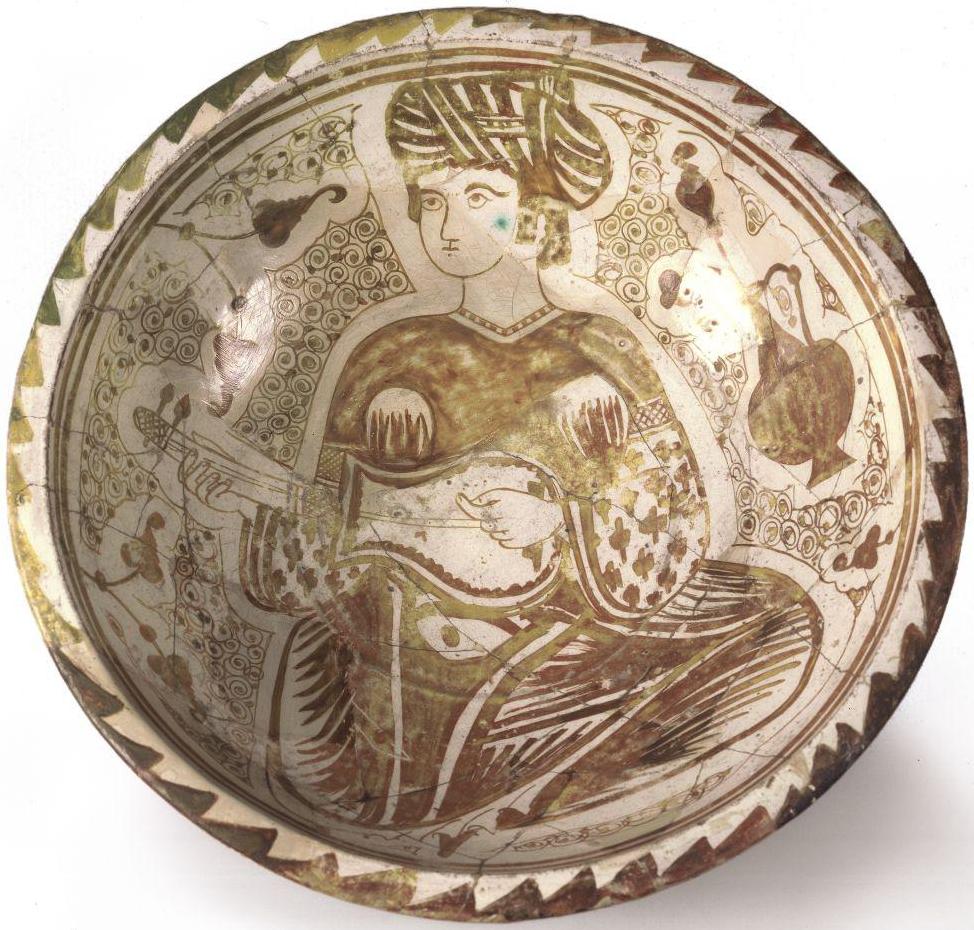
Create an Amazon Business Account
Fatimid Lustre Painted Large Dish, 11th century



Economic prosperity in the Fatimid period led to the flourishing of the lustre-ware ceramic industry. Such lustre-ware vessels, where the metallic lustre resembles gold, incorporate a variety of decorations including splendid scenes of Fatimid daily and social life.
Lustre painted celadon or porcelain.
Found at Fustat, Egypt.
Fatimid era (5th century AH / 11th century AD), 15 x 40 cm.
Museum of Islamic Art, Cairo. Source: Museum with no Frontiers
Dish with female rebab player
This large dish is decorated with metallic lustre, a technique that probably originated in Iraq in the ninth century. This process was used in Egypt during the Tulunid dynasty (868–905), thanks to the importations of Mesopotamian pieces, but wasn’t mastered until the tenth century, a period that corresponds with the decline of the ʿAbbāsid empire. The workshops were probably located in Fūstat, the economic heart of the country. The lustre technique was used from the eleventh century in the Maghrib[1], and in the twelfth century, it spread towards Iran and Andalusia, where the centres of Almeria, Murcia, and then Malaga developed. Still used in Spain after the fall of Granada, it also became popular in Renaissance Italy, in the centres of Deruta and Gubbio.
- Title/name : Dish with female rebab player
- Production place : Egypt
- Date / period : The eleventh century
- Materials and techniques : Ceramics; lustre decorations
- Dimensions : Diameter 40cm
- Conservation town : Cairo
- Conservation place : The Museum of Islamic Art
- Inventory number : 14923
This dish attests to the strong influence of ʿAbbāsid monochrome lustre. The ground is decorated with small scrollwork—present on other contemporary works[2]—motifs derived from ocelli or ‘eyes of Peacock feathers’, which were very common on lustred Iraqi objects. And, as on the dish with lute player in the Freer Gallery of Washington, dating from the tenth century, the motifs are separated from the ground with a white border. This arrangement is also seen on the handles of an Alhambran vase, at the beginning of the fourteenth century[3]. The edge is no longer adorned with fillets but small inclined triangles that can be seen on other Fātimid[4] dishes. Stylistically, the young woman’s representation matches the characteristics of Fātimid art: the chest is represented schematically by two small circles located almost under the armpits, and the belly button is represented in the same way as on the dish with the dancing woman in the Freer Gallery.
The iconography of the musician—with its references to princely pleasures—is a common figure with the Fātimids, where it was used on ivory[5] and wooden[6] objects. A dish with a different style, probably made a little later, has a very similar iconography[7]. Female musicians are also present in other places and eras, in Spain, or, for example, in the Iranian world. Numerous figures of musicians, playing the lute or the drums can also be seen on the decorations in the Palatine Chapel of Palermo, perhaps created by Fātimid artists. Similar iconography can be seen in manuscripts and on Western capitals from the twelfth century[8], but with a very different meaning and style. Often a man or angel is holding the instrument, as women were restricted to the role of dancer.
Here, the young woman is not holding an oud, which is a lute with a short handle and four or five strings, but a rebab, a long-handled instrument with two strings, whose body has a bulbous shape. This particular lute can be observed on at least another ʿAbbāsid[9] lustred ceramic, as well as on a piece of Fātimid woodwork[10]. While certain long-handled lutes came from Pharaonic Egypt (fresco of the tomb of Djeserkare, fifteenth century BC), this one originated in Iran, where it was created in the tenth century. Abandoned for the tar (a long-necked Iranian instrument), it spread to the Himalayas and South-East Asia, and was frequently represented in Mughal painting, but with a number of modifications. It was also considered to be the Afghan national instrument. Today, however, the term ‘rebab’ in the Near East and the Muslim West designates another type of instrument, that also had two strings, but which was played with a bow, and is the ancestor of the European rebec. NOTE
[1] Tiles of the Qal’a of the Banu Hammad, National Museum, Setif, IS 118, IS 120
[2] Dish with giraffe, Benaki Museum, 749
[3] Alhambra vase, the Hermitage Museum, Saint Petersburg, F 317
[4] Cup with winged lion, The Museum of Islamic Art, Cairo, 14928.
[5] Facing panels, museum für islamische Kunst, Berlin, I 6375
[6] Decorative frieze from the māristān of Qalā'ūn, The Museum of Islamic Art, Cairo.
[7] Dish with lute player,The Museum of Islamic Art, Cairo. Here, the young woman is holding her instrument to the left. The clothes and their treatment are similar. The serrated frieze around the rim, and the presence of a ewer and vegetal motifs around the central person may indicate the use of a common model for the two pieces.
[8] Breviary of Montiéramey, Fo. 212 Vo., twelfth century, Paris, BNF, MS. lat. 796.; capitals in the cloister of the Abbey Saint-Georges de Boscherville (Normandy), c.1170, Musée départemental des antiquités de la Seine-Maritime, Rouen, France, 139–39 A.
[9] Dish with rebab player, Freer Gallery of Art, Washington
[10] Decorative element, the Louvre Museum, Paris, OA 4062
Source: qantara